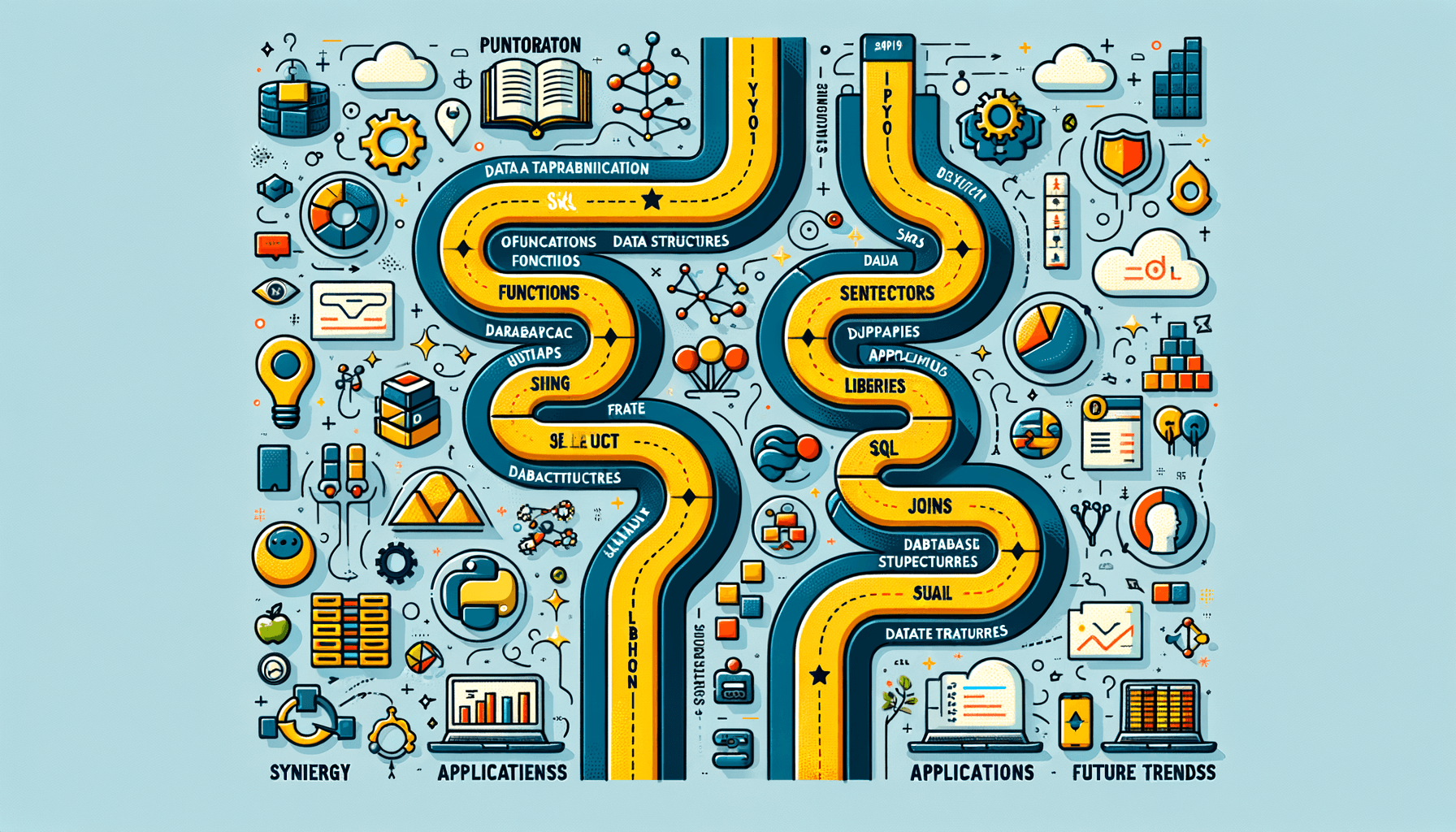A big variety of articles and resources

Learn SQL and Python: A Dual Approach to Data Mastery
 Sia Author and Instructor
Learn SQL
Sia Author and Instructor
Learn SQL
11 minute read
In today's data-driven world, mastering both SQL and Python can give you a big advantage. SQL helps you manage and query data, while Python lets you analyze and manipulate it. Together, they create a powerful toolkit for anyone looking to work with data. This article will guide you through the basics of both languages and show you how to use them together for advanced data tasks.
Key Takeaways
- SQL and Python work well together to handle and analyze data.
- Learning both languages can open up many job opportunities.
- You can use SQL for managing databases and Python for data analysis.
- Combining SQL and Python can automate many data tasks.
- Understanding these tools can help you solve real-world problems.
The Synergy Between SQL and Python
Understanding the Interplay of SQL and Python
When we combine SQL and Python, we unlock a powerful toolkit for data tasks. SQL is great for managing and querying databases, while Python excels at data analysis and manipulation. Together, they allow us to handle data from start to finish, making our work more efficient and effective.
Advantages of Combining SQL and Python
Using SQL and Python together offers several benefits:
- Efficiency: SQL handles large datasets quickly, and Python processes data smoothly.
- Flexibility: Python's libraries, like Pandas, make it easy to work with data in various formats.
- Integration: We can connect Python to SQL databases, allowing seamless data flow between the two.
Real-World Applications of SQL and Python Integration
In real-world scenarios, the combination of SQL and Python is invaluable. For instance, in business intelligence, we can use SQL to extract data and Python to create visualizations. In data cleaning, SQL helps filter and sort data, while Python scripts handle complex transformations. This synergy is also crucial in machine learning, where SQL retrieves training data and Python builds predictive models.
By leveraging the strengths of both SQL and Python, we can tackle a wide range of data challenges efficiently and effectively.
Fundamentals of SQL for Data Management
Core Concepts of SQL
SQL, or Structured Query Language, is the backbone of database management. It allows us to interact with databases, retrieve data, and perform various operations. Understanding the basic concepts of SQL is crucial for anyone working with data. These concepts include tables, rows, columns, and relationships between tables. By mastering these fundamentals, we can efficiently manage and manipulate data.
Essential SQL Commands and Syntax
To work with SQL, we need to be familiar with its commands and syntax. Some of the most important SQL commands include:
- SELECT: Used to retrieve data from a database.
- INSERT: Adds new data to a table.
- UPDATE: Modifies existing data.
- DELETE: Removes data from a table.
Each command has a specific syntax that must be followed. For example, the SELECT command is used as follows:
SELECT column1, column2 FROM table_name WHERE condition;
Best Practices for Writing Efficient SQL Queries
Writing efficient SQL queries is essential for optimizing database performance. Here are some best practices to follow:
- Use indexing to speed up data retrieval.
- Avoid using SELECT *; instead, specify the columns you need.
- Use joins wisely to combine data from multiple tables.
- Filter data using the WHERE clause to reduce the amount of data processed.
By following these best practices, we can ensure that our SQL queries run smoothly and efficiently, even with large datasets.
Python for Data Analysis and Manipulation
Introduction to Python for Data Science
Python has become a cornerstone in the field of data science. Its simplicity and readability make it an excellent choice for both beginners and experienced professionals. Python's versatility allows us to handle a wide range of data tasks, from data cleaning to complex statistical analysis.
Key Python Libraries for Data Analysis
Several libraries in Python are essential for data analysis. Here are a few key ones:
- Pandas: Ideal for data manipulation and analysis.
- NumPy: Provides support for large multi-dimensional arrays and matrices.
- Matplotlib: Used for creating static, animated, and interactive visualizations.
- SciPy: Useful for scientific and technical computing.
- Scikit-learn: A library for machine learning.
Writing Python Scripts for Data Manipulation
Writing Python scripts for data manipulation involves several steps. First, we import the necessary libraries. Next, we load the data, often from a CSV file or a database. Then, we clean and preprocess the data, which may include handling missing values and normalizing data. Finally, we perform the analysis or manipulation needed for our specific task.
Python scripts can automate repetitive tasks, saving time and reducing errors. This makes Python an invaluable tool in data analysis and manipulation.
Integrating SQL and Python for Advanced Data Tasks
Connecting Python to SQL Databases
To start, we need to connect Python to SQL databases. This is done using libraries like sqlite3 or SQLAlchemy. These tools help us link Python scripts to our database, making it easy to run queries and handle data. This connection is crucial for any data project that uses both SQL and Python.
Executing SQL Queries from Python
Once connected, we can execute SQL queries directly from Python. This allows us to fetch, insert, update, or delete data without leaving our Python environment. For example, we can use pandas to read SQL query results into a DataFrame, making data analysis more seamless. This step is essential for tasks like data cleaning and transformation.
Automating Data Workflows with SQL and Python
Combining SQL and Python also lets us automate data workflows. We can write scripts that run at set times, pulling data, processing it, and storing results back in the database. This is especially useful for regular reports or data updates. By automating these tasks, we save time and reduce errors.
In our mini course: SQL functions and techniques for BI professionals, we cover advanced SQL functions, sorting techniques, and data handling. This practical skills enhancement with real-world problems is led by instructor Eric Vanier.
Case Studies: SQL and Python in Action
Business Intelligence and Reporting
In the realm of business intelligence, SQL and Python work together to turn raw data into meaningful insights. We can use SQL to extract data from various databases and then employ Python to create visualizations and reports. This combination allows us to make data-driven decisions quickly and efficiently. For example, a company might use SQL to pull sales data and Python to generate a sales performance dashboard.
Data Cleaning and Transformation
Data cleaning is a crucial step in any data project. SQL helps us filter and sort data, while Python can handle more complex transformations. By using both tools, we can ensure our data is accurate and ready for analysis. For instance, SQL can be used to remove duplicate records, and Python can fill in missing values or correct data types.
Machine Learning and Predictive Analytics
Machine learning models require clean and well-structured data. SQL can be used to gather and preprocess this data, while Python is ideal for building and training the models. Combining these tools allows us to create powerful predictive analytics solutions. For example, we might use SQL to collect customer data and Python to predict future buying behavior.
By integrating SQL and Python, we can tackle a wide range of data tasks more effectively. This synergy not only enhances our productivity but also opens up new possibilities for data analysis and decision-making.
Challenges and Solutions in Using SQL and Python Together
Common Pitfalls and How to Avoid Them
When working with SQL and Python, we often encounter several common pitfalls. One major issue is the mismatch between SQL's set-based operations and Python's iterative nature. This can lead to inefficient data processing if not handled properly. To avoid this, we should leverage SQL for heavy data lifting and use Python for more complex, iterative tasks. Another common problem is poor error handling, which can cause our scripts to fail unexpectedly. Implementing robust error handling mechanisms can help mitigate this risk.
Performance Optimization Techniques
Optimizing performance is crucial when integrating SQL and Python. One key technique is to minimize the number of database queries by fetching all necessary data in a single query whenever possible. This reduces the overhead of multiple round-trips to the database. Additionally, using indexing in SQL can significantly speed up query execution times. In Python, we can optimize performance by using efficient data structures and algorithms, such as pandas DataFrames for data manipulation.
Security Considerations and Best Practices
Security is a critical aspect of using SQL and Python together. We must ensure that our applications are protected against SQL injection attacks by using parameterized queries. It's also important to manage database credentials securely, avoiding hard-coding them in our scripts. Instead, we can use environment variables or secure vaults to store sensitive information. Regularly updating our software and libraries helps protect against known vulnerabilities.
Integrating SQL and Python offers powerful capabilities, but it also comes with its own set of challenges. By understanding and addressing these issues, we can create more efficient and secure data workflows.
Future Trends in SQL and Python Integration
Emerging Technologies and Tools
As we look ahead, the integration of SQL and Python is set to be influenced by several emerging technologies. One key trend is the rise of cloud-based data platforms that offer seamless integration between SQL databases and Python environments. These platforms not only enhance scalability but also simplify data management tasks. Additionally, advancements in machine learning frameworks are making it easier to embed SQL queries within Python scripts, streamlining the data analysis process.
Evolving Best Practices
The best practices for combining SQL and Python are continually evolving. We are seeing a shift towards more modular and reusable code, which improves maintainability and collaboration. Another important trend is the increased focus on data security and privacy, prompting the development of new techniques for secure data handling. Furthermore, the adoption of version control systems for SQL scripts is becoming more common, ensuring that changes are tracked and managed effectively.
The Future of Data Science with SQL and Python
The future of data science is bright with the continued integration of SQL and Python. We anticipate that the synergy between these two powerful tools will lead to more efficient and insightful data analysis. Automation will play a significant role, with more tasks being automated to save time and reduce errors. Moreover, the growing community of data scientists and developers will continue to contribute to open-source projects, driving innovation and expanding the capabilities of both SQL and Python.
The future of SQL and Python integration is bright, with new trends making it easier to combine these powerful tools. Whether you're a beginner or looking to advance your skills, our courses can help you stay ahead of the curve. Visit our website to explore our course catalog and find the perfect fit for your learning journey. Don't miss out on the opportunity to enhance your technical skills and career prospects!
Conclusion
In summary, learning both SQL and Python can greatly improve your data skills. SQL helps you get data from databases, while Python lets you analyze and visualize it. Together, they make a powerful team for anyone who wants to work with data. By mastering these tools, you can open up many new job opportunities and become more valuable in the job market. So, start learning today and take the first step towards becoming a data expert.
Frequently Asked Questions
What is the benefit of learning both SQL and Python?
Learning both SQL and Python gives you a powerful set of tools for working with data. SQL is great for managing and querying databases, while Python is excellent for analyzing and manipulating data. Together, they allow you to handle a wide range of data tasks.
Can I use SQL and Python together?
Yes, you can use SQL and Python together. Python can connect to SQL databases, allowing you to run SQL queries from within Python scripts. This makes it easier to automate data workflows and perform complex data tasks.
Do I need to be good at math to learn SQL and Python?
No, you don't need to be a math expert to learn SQL and Python. While some data tasks may involve math, both SQL and Python are more about understanding how to work with data. Basic math skills are usually enough.
What are some real-world uses of SQL and Python?
SQL and Python are used in many real-world applications. They are commonly used in business intelligence, data cleaning, machine learning, and predictive analytics. Companies use them to make data-driven decisions and solve complex problems.
Is it hard to learn SQL and Python at the same time?
Learning SQL and Python at the same time can be challenging, but it's definitely doable. Start with the basics of each language and gradually work your way up. Practice regularly and use online resources to help you along the way.
What are the best resources for learning SQL and Python?
There are many great resources for learning SQL and Python. Online courses, tutorials, and books are all good options. Websites like Codecademy, Coursera, and Khan Academy offer interactive lessons that can help you learn at your own pace.
Related Articles

3 Juicy Secrets Behind Sluggish SQL!!
5 minute read

Can I learn SQL without any programming knowledge?
12 minute read

How Difficult Is SQL to Learn? A Comprehensive Guide
8 minute read




